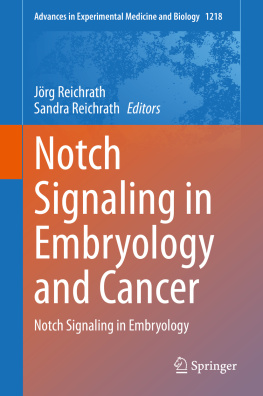Volume 1218
Advances in Experimental Medicine and Biology
Series Editors
Wim E. Crusio
Institut de Neurosciences Cognitives et Intgratives dAquitaine, CNRS and University of Bordeaux UMR 5287, Pessac Cedex, France
John D. Lambris
University of Pennsylvania, Philadelphia, PA, USA
Heinfried H. Radeke
Institute of Pharmacology & Toxicology, Clinic of the Goethe University Frankfurt Main, Frankfurt am Main, Germany
Nima Rezaei
Research Center for Immunodeficiencies, Childrens Medical Center, Tehran University of Medical Sciences, Tehran, Iran
Advances in Experimental Medicine and Biologyprovides a platform for scientific contributions in the main disciplines of the biomedicine and the life sciences. This book series publishes thematic volumes on contemporary research in the areas of microbiology, immunology, neurosciences, biochemistry, biomedical engineering, genetics, physiology, and cancer research. Covering emerging topics and techniques in basic and clinical science, it brings together clinicians and researchers from various fields
Advances in Experimental Medicine and Biologyhas been publishing exceptional works in the field for over 40 years, and is indexed in SCOPUS, Medline (PubMed), Journal Citation Reports/Science Edition, Science Citation Index Expanded (SciSearch, Web of Science), EMBASE, BIOSIS, Reaxys, EMBiology, the Chemical Abstracts Service (CAS), and Pathway Studio.
2018 Impact Factor: 2.126.
More information about this series at http://www.springer.com/series/5584
Editors
Jrg Reichrath and Sandra Reichrath
Notch Signaling in Embryology and Cancer
Notch Signaling in Embryology
Editors
Jrg Reichrath
Department of Dermatology, The Saarland University Hospital, Homburg, Saarland, Germany
Sandra Reichrath
Department of Dermatology, The Saarland University Hospital, Homburg, Saarland, Germany
ISSN 0065-2598 e-ISSN 2214-8019
Advances in Experimental Medicine and Biology
ISBN 978-3-030-34435-1 e-ISBN 978-3-030-34436-8
https://doi.org/10.1007/978-3-030-34436-8
Springer Nature Switzerland AG 2020
This work is subject to copyright. All rights are reserved by the Publisher, whether the whole or part of the material is concerned, specifically the rights of translation, reprinting, reuse of illustrations, recitation, broadcasting, reproduction on microfilms or in any other physical way, and transmission or information storage and retrieval, electronic adaptation, computer software, or by similar or dissimilar methodology now known or hereafter developed.
The use of general descriptive names, registered names, trademarks, service marks, etc. in this publication does not imply, even in the absence of a specific statement, that such names are exempt from the relevant protective laws and regulations and therefore free for general use.
The publisher, the authors, and the editors are safe to assume that the advice and information in this book are believed to be true and accurate at the date of publication. Neither the publisher nor the authors or the editors give a warranty, expressed or implied, with respect to the material contained herein or for any errors or omissions that may have been made. The publisher remains neutral with regard to jurisdictional claims in published maps and institutional affiliations.
This Springer imprint is published by the registered company Springer Nature Switzerland AG
The registered company address is: Gewerbestrasse 11, 6330 Cham, Switzerland
We dedicate this book to our sons, Niklas and Benjamin, the absolute joy of our lives.
Preface
When the American scientist John S. Dexter discovered mutant fruit flies (Drosophila melanogaster) in his research laboratory at Olivet College (Olivet, Michigan) more than a century ago, he could not have expected the tremendous impact that the characteristic notch-wing phenotype (a nick or notch in the wingtip that gave the responsible gene the name Notch) would later have for many fields of biology and medicine, including embryology, genetics, and cancer. During the last decades, a huge mountain of impressive scientific process has convincingly demonstrated that Notch signaling represents one of the most fascinating pathways that govern cellular core processes including cell fate decisions, embryogenesis, and adult tissue homeostasis. Therefore, it is no surprise that the first edition of the bookNotch Signaling in Embryology and Cancer, published by Landes and Springer in 2012 in the prestigious series Advances in Experimental Medicine and Biology, was very successful, for it fulfilled the need to provide a broad audience (ranging from medical students to basic scientists, physicians, and all other healthcare professionals) with up-to-date information in a comprehensive, highly readable format. At this time, it was the benchmark on this topic, with individual chapters being written by highly respected experts in the field. Because of the enormous progress that has been made on this topic in recent years, we have decided that it is now the right time to publish an updated and extended version. The second edition of the abovementioned book has been expanded substantially and consequently has been divided in three separate volumes to include many new chapters. In its different volumes, leading experts in the field present a comprehensive, highly readable overview on selected aspects of three important topics related to Notch signaling, namely, the underlying molecular mechanisms that mediate its biological effects (Volume I), its role in embryogenesis (Volume II), and last but not least its relevance for pathogenesis, progression, prevention, and therapy of cancer (Volume III). This second volume summarizes the fascinating role of this pathway, which was first developed during the evolution in metazoans and was first discovered in the fruit flyDrosophila melanogaster, for embryology. We are convinced that it will be as successful as the previous edition and are very grateful for the willingness of all authors to contribute to this book. We would also like to express our thanks to Murugesan Tamilselvan, Anthony Dunlap, Larissa Albright, and all other members of the Springer staff for their expertise, diligence, and patience in helping us complete this book.
Enjoy the reading!
Jrg Reichrath
Sandra Reichrath
Homburg, Saarland, Germany
Contents
Jrg Reichrath and Sandra Reichrath
Jrg Reichrath and Sandra Reichrath
Shahrzad Bahrampour and Stefan Thor
Chuanxian Wei , Chung-Weng Phang and Renjie Jiao
Makoto Sato and Tetsuo Yasugi
Tetsuichiro Saito
Sergio Crdoba and Carlos Estella
Nicolas Daudet and Magdalena ak
Jrg Reichrath and Sandra Reichrath
Contributors
Shahrzad Bahrampour
The Hospital for Sick Children, Peter Gilgan Center for Research and Learning, Toronto, ON, Canada
Karolinska Institutet, Department of Cell and Molecular Biology (CMB), Stockholm, Sweden
Sergio Crdoba
Centro de Biologa Molecular Severo Ochoa, CSIC-UAM, Madrid, Spain












